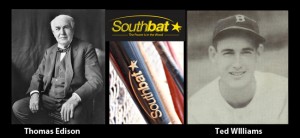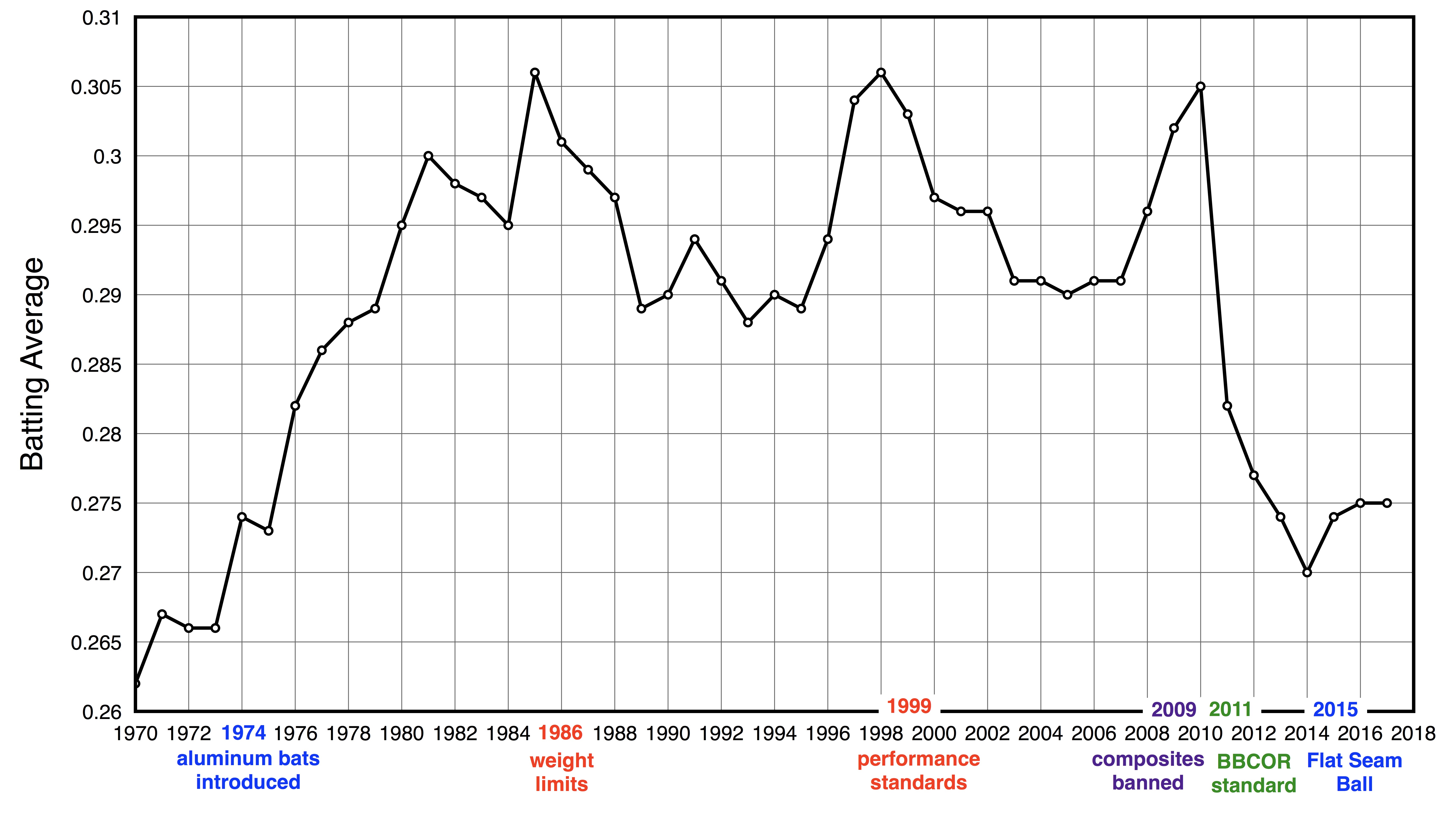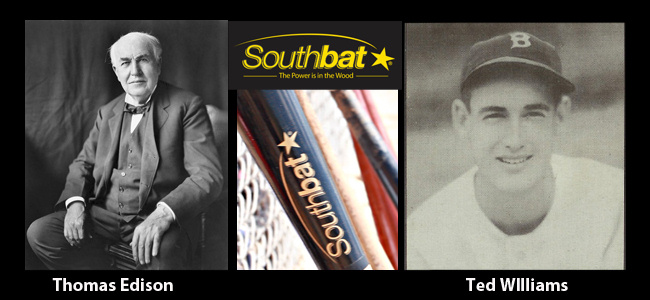(Note: This is the second installment of a two part article. The first part was published last week at this link) 
Wood and Metal Bats
With the adoption of the BBCOR (bat-ball coefficient of restitution) standard of certification for college and high school baseball bats over the past few years, the debate over metal versus wood bats has changed.
The Shift to Wood Bats
I know from my experience and my research that there has been a shift from metal back to wood. Most of this stems from safety concerns, but part of the shift has to do with professional baseball emulation—players want to use what the pros use. Over the past few years, I have noticed the trend of more and more wood bat tournaments and I have seen some of the most competitive baseball leagues ban metal bats especially in older age groups.
When the metal bat certification standards moved from BESR (bat exit speed ratio) to BBCOR (bat-ball coefficient of restitution) in 2011 for colleges and in 2012 for high schools, the game changed dramatically. Many players don’t realize that this standard was yet another move towards wood bats. The plan was to allow only metal bats that had a BBCOR value comparable to the best wood bats available. The net effect of this change in standards was that metal bats lost their trampoline effect advantage. In this respect, the new BBCOR bats and wood bats perform exactly the same level in terms of ball speed coming off the bat.
Still Differences Between Wood and Metal?
There is one notable difference between metal and wood bats under the new BBCOR standard. The BBCOR bat’s MOI (moment of inertia) is lower in the metal bats which means that it is more maneuverable in that it has more weight shifted toward the handle. You might be able to generate more bat speed with a metal bat which means you can wait on a ball a bit longer and make contact more often, but you aren’t going to hit the ball any farther than with a wood. According to Dr. Alan Nathan, “[a] batter may get a higher swing speed with a lower MOI bat, but that is almost completely compensated by a less effective collision with the ball because there is less weight behind that collision.” You can find Dr. Nathan’s discussion of this concept at this link.
Show Me the Numbers
The early results are in and the numbers show that there is no real measurable difference between wood and metal bats after the adoption of the BBCOR standard. Batting averages of NCAA Division 1 players have dropped back to close to the wood-only era of the early 1970s suggesting there is no overall difference between metal and wood now.

You can see all of Dr. Daniel Russell’s research at this link. Dr. Russell states his conclusion as follows: “By the end of the 2011 season, batting averages dropped almost to pre-aluminum values. This is very significant. Using the new BBCOR bats, players are not putting the ball into play nearly as frequently as they did in previous years.”
Physics Doesn’t Measure Fit and Confidence
After the adoption of the BBCOR standard, the selection of wood or a metal has truly become a player’s choice. Going forward, coaches should be tolerant of a player’s selection of wood over metal.
The mental side of baseball is a big part of the game. Some rightly point out that we are all wired differently (yes, I’m talking about neuroscience here). This concept should extend to baseball too. Maybe Ted Williams was on to more than he knew when he said that “hitting a baseball is 50% from the neck up.” When you pick up a bat for the first time and toy with it, your brain is trying to figure out if that bat is going to work for you. While one bat may be good a good fit for one player, it might not be a good fit for another.
Confidence is certainly a part of the equation. If a player likes wood over metal because he likes the feel, he is more likely to perform better. If there is one thing Ted Williams never lacked, it was confidence. Once he said, “If there was ever a man born to be a hitter it was me.” Ted William’s single minded purpose in life was to be remembered as the best hitter ever in the game. He took pride in his craft. He always felt a need to prove himself to any doubters as to his hitting ability. He was a fiercely independent man.
In 1993, long after he retired from baseball, Williams wrote to Louisville Slugger and said, “I’d have been a .290 hitter without a Louisville Slugger.” This is an amazing quote from Ted Williams. In my opinion, he really believed in the fit of his bat and the confidence it gave him; otherwise, he wouldn’t have said what he did. I don’t think that Ted Williams would have given anyone or anything gratuitous credit for his hitting talent.
You have to sit up and take notice when Ted Williams gives credit to something other than his abilities or his practice. Williams concluded his career with a lifetime .344 batting average. If he finished as a .290 hitter, he would have been 313th on the all time batting average list as opposed to 7th. He really believed in his wood bat.
Getting back to Dr. Russell’s research, he concludes his analysis of comparing wood to metal after BBCOR by saying: “The adoption of the BBCOR=0.50 standard appears to be returning batting averages, home runs per game, and runs scored per game to levels very near those of the ‘wood-only’ days in the early 1970’s.” There are charts backing his conclusion at this link.
Given the above, every player needs to start looking at wood bats now as a viable alternative or supplement to metal. In fact, for the serious player, a wood bat should be in his bat bag if he expects to be playing in wood bat tournaments or in wood-only leagues.
Southbat
When I first learned about Southbat last year, I was intrigued by its Guayaibi wood bat. Sebastian Naum and Luis Cabrera started the company back in 2008 after Louis discovered an old sawmill in the forests of Argentina where Guayaibi, a hardwood, was harvested for furniture, floors and boating. They did some scientific research on the wood and believed its properties would be suitable for use as baseball bats.
If Thomas Edison were charged with making a better wood baseball bat, he would have appreciated Southbat’s approach. Edison was famous for looking at everything as a possible source of a product. Edison collected plant and tested specimens from all over the world. That’s the way Edison rolled. He took a thorough approach in everything he did. When Edison was searching for a plant to use in the manufacture of rubber, he looked at over ten thousand kinds of plants. You may have heard of bamboo bats, but you probably didn’t know that Edison tried to use bamboo to create long lasting filaments for his incandescent light. One has to appreciate Southbat’s scientific approach to choosing this tree to manufacture its bats.
Would Ted Williams have tried a Southbat made of Guayaibi? Yes, I think so. Williams was obsessive about his bat. As a teen, he would carry his bat to school and to classes. He cared for his bats like nobody else. In the majors, he would take his bats to the post office to use the scale there to make sure they were the right weight. He would clean his bats himself during his career with rubbing alcohol and told other players not to let their bats lie around on the ground because they would collect moisture and throw off the bat’s weight. Once Williams was given a group of six bats with one a half ounce lighter than the rest. He picked out the light bat. He would even visit the bat factory to make sure his bats were made to specification and picked out the wood used for his bats. Williams wasn’t afraid to try something different. He ordered a few Adirondack bats to test. Obviously, Ted Williams found a bat that both fit his style and gave him confidence.
Would Southbat’s Guayaibi bat fit your style? Many players have found that Southbat is their bat. There’s one way to discover if Southbat fits your style, and that’s to try one out.
Resources


HI James,
Thanks for sharing your thoughts.
First, whatever bat works for you is the one you should use, whether it is metal or wood.
In doing my research, I came across the claim that some metal bats have larger sweet spots than wood.
Assuming that’s true, then the bigger sweet spot doesn’t seem to have amounted to anything overall so far at D1 colleges as home runs, runs per game and batting averages have pretty much reverted to pre-metal, pre BBCOR era when wood bats were the only game in town.
From Noah:
“Wood is way better now that we have to use these BBCORs. I have used wood all winter and it has way more pop than these new bats”.